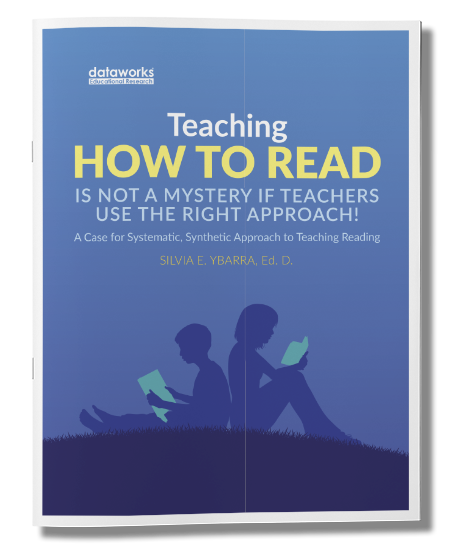Learn the Do’s and Don’ts for success in teaching reading. Find out how success in reading is built on five research-based pillars: Phonemic awareness, Phonics, Fluency, Vocabulary, and Comprehension. Written by Silvia Ybarra, Ed. D.
What is Launch to Literacy
The Launch to Literacy ELD curriculum is structured in a way that the message of how to read, write, and use language is consistent with how English is taught to native speakers. This systematic, synthetic phonics approach begins with simple skills and concepts and advances in complexity as students advance from starting to developing English learners.
The Launch to Literacy ELD curriculum is also structured in a way that the message of how to read, write, and use language is consistent across every level. This feature is vital as students are accelerated through the fast-paced ELD program. With Launch to Literacy, students will be learning to read new words after the first few lessons!
Teach students to read with this comprehensive English Language Development (ELD) curriculum:
"I am so excited to see the progress that our EL students are making. I have a sixth-grader that I'm working with who is literally killing it with his progress. This kid knows his digraphs and can segment and blend like a professional!!!"
Teresa Cottier – Teacher, Antelope Elementary
English Language Development (ELD) Curriculum
DataWORKS’ comprehensive ELD curriculum addresses the five vital components of literacy instruction, as identified by the National Reading Panel, in a turn-key ELD curriculum for English learners.
The Five Components
Phonemic awareness is the ability to hear that a spoken word is made up of a series of discrete sounds. This is not just important in English, but phonemic awareness is critical for any language that has an alphabetic writing system.
Phonemic Awareness
Phonemic awareness is the ability to hear that a spoken word is made up of a series of discrete sounds. This is not just important in English, but phonemic awareness is critical for any language that has an alphabetic writing system.
Phonics
Phonics instruction is teaching children that specific sounds belong to specific letters and letter patterns. Phonics instructions helps children recognize and associate the sounds of the letters and letter patterns in the words they read.
Fluency
Fluency is a child’s ability to effortlessly and correctly read, speak, and write English. Fluency in reading should include consistent speed, accuracy, and the use of proper expression.
Vocabulary Development
Vocabulary can be defined as the knowledge of words and their meanings. The purpose of teaching vocabulary is for children to understand words and to use them to acquire and convey meaning.
Reading Comprehension
Comprehension refers to a child’s understanding of what they are reading. This not only includes reading, but also what is written.
This ELD Curriculum also includes: Language, Writing & Spelling
"I am so happy with it and it engages my students so well! I can really tell it helps. The teachers even tell me students read well in class. (Aloud)"
Lauren Khalifa – Teacher, Key Academy Charter
Teaching Phonics
Global Movement
The systematic, synthetic phonics approach to literacy has been adopted by the majority of English-speaking countries in the world as the approach best suited for ELD students having difficulty learning to read.

Launch to Literacy Samples
The Launch to Literacy curriculum is aligned to state and national English Language Development (ELD) standards. Click here to read more.
LEVEL
A
Assessment Samples
LEVEL
B
Assessment Samples
Sample Workbooks
See Launch to Literacy in Action
The videos below are real classroom teachers using the Launch to Literacy ELD curriculum to help students learn to read in their classrooms. Video #1 shows a teacher teaching ELD students how spelling patterns can inform them how to pronounce a word. Video #2 demonstrates an ELD teacher using the tracked reading strategy. Video #3 shows how checking for understanding throughout the lesson allows the ELD teacher to assess whether students are learning in real-time.
Spelling Patterns
Alphabet
Checking for Understanding
Have Any Questions?
Fill out the form with your school email address, and we will get back to you.
We will reach out to schedule a meeting with you.
Alternatively, you can book a phone or Zoom appointment directly by following this link: https://dataworks-ed.com/book-appointment/
Frequently Asked Questions
The Launch-to-Literacy levels are aligned with similar levels to TESOL, EL Standards, ELD Standards, ELP Standards, and WIDA ELD Standards.
Another quick way to determine the best fit for students is to review the Scope and Sequence documents for levels A, B, and C above. Each document gives a comprehensive overview of what is taught at that level.
Launch to Literacy is designed to fit the needs of any ELD teacher. Teachers who have more dedicated time for ELD instruction can use the entire 2.5 hour program each day. Teachers who only have a small window of time for ELD instruction can use only the components they need.
For example, one school that is currently using Launch to Literacy came to us because their students were struggling with phonics and phonemic awareness, but teachers only had 35 minutes per day to dedicate to ELD instruction. Therefore, we suggested that they focus on the phonemic awareness and phonics blocks only.
Over the years DataWORKS has studied hundreds of textbook adoptions, including the major ones that have recently been adopted for Common Core. Most textbooks on the market today provide English Learner accessible content, not English Language Development content. Accessible content teaches students English Language Arts, and as an aside, they provide shortened stories and simplified questions that are more accessible to English learners. Launch to Literacy systematically teaches students to read, write, and speak English.
That doesn’t mean English learners should not receive grade-level ELA instruction. They absolutely should! But they also need to receive systematic ELD instruction to build English proficiency.
Teachers receive complete access to the Launch to Literacy program for one full year for $250 per teacher (that’s less than $1.50 per day!). Quantity discounts do apply.
Please call our office (800) 495-1550 to inquire about student workbook pricing.















